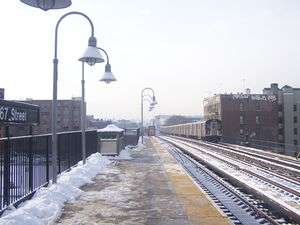167th Street station (IRT Jerome Avenue Line)
167th Street is a local station on the IRT Jerome Avenue Line of the New York City Subway. Located at the intersection of 167th Street and River Avenue in the Bronx, it is served by the 4 train at all times.
167 Street | |||||||
|---|---|---|---|---|---|---|---|
 Two trains running on the 4 service (one arriving, one leaving) at the 167th Street Station, facing southbound. | |||||||
| Station statistics | |||||||
| Address | East 167th Street & River Avenue Bronx, NY 10452 | ||||||
| Borough | The Bronx | ||||||
| Locale | Highbridge, Concourse | ||||||
| Coordinates | 40.835665°N 73.921337°W | ||||||
| Division | A (IRT) | ||||||
| Line | IRT Jerome Avenue Line IRT Ninth Avenue Line (formerly) | ||||||
| Services | 4 | ||||||
| Transit connections | |||||||
| Structure | Elevated | ||||||
| Platforms | 2 side platforms | ||||||
| Tracks | 3 (2 in regular service) | ||||||
| Other information | |||||||
| Opened | June 2, 1917 | ||||||
| Station code | 388[1] | ||||||
| Opposite-direction transfer available | Yes | ||||||
| Traffic | |||||||
| Passengers (2019) | 2,653,237[2] | ||||||
| Rank | 182 out of 424[2] | ||||||
| Station succession | |||||||
| Next north | 170th Street: 4 Burnside Avenue (some rush-hour trains): 4 | ||||||
| Next south | Anderson–Jerome Avenues (Ninth Ave elevated; demolished) 161st Street–Yankee Stadium: 4 | ||||||
| |||||||
| |||||||
| |||||||
Station layout
| P Platform level |
Side platform | |
| Northbound local | ← ← | |
| Peak-direction express | No regular service | |
| Southbound local | | |
| Side platform | ||
| M | Mezzanine | Fare control, station agent, MetroCard machines |
| G | Street level | Entrances/exits |
The station has three tracks with two side platforms. It opened in 1917, and Ninth Avenue Elevated trains started serving the station on July 1, 1918.[3] The station was rehabilitated in 2004. It has old-style signs that have been painted over and covered up with new-style signs. It also features new fare control railings as a crossunder.
Exits
Fare control is situated in the mezzanine under the tracks. Outside of the fare control area, exit stairs go to all corners of River Avenue and 167th Street.[4]
Polo Grounds Shuttle
From 1940 to 1958, 167th Street served as a terminal for the last remnant of the Ninth Avenue Elevated operating from 155th Street (Polo Grounds) to 167th Street. On reaching 167th Street, trains would switch to the center track, change direction, and return to 155th Street on the downtown track. Service was eventually reduced to a single two-car train operating in both directions on the uptown track.[5] In 1958, service was discontinued after the New York Giants left for San Francisco. From the southern end of the station, the ramps leading to the Ninth Avenue line structure can still be seen. These ramps end south of the southwest corner of River Avenue and 164th Street, between Gate 8 and the 164th Street parking garage at Yankee Stadium.
In 1940, the New York City Board of Transportation proposed that the IRT Ninth Avenue Line should be connected to the IRT Lenox Avenue Line near the current Harlem–148th Street station.[6] However, the tunnel from Sedgwick Avenue to Anderson–Jerome Avenues was built to elevated-railway standards, whose "open" third rails were shorter than the subway's "covered" third rails, as the "open" rails did not have any protective covers on top. This incompatibility prevented the connection from being built.[7] Another issue was that the Ninth Avenue Line could not carry subway cars, it was only strong enough to carry the lighter elevated cars.[8]:244
References
- "Station Developers' Information". Metropolitan Transportation Authority. Retrieved June 13, 2017.
- "Facts and Figures: Annual Subway Ridership 2014–2019". Metropolitan Transportation Authority. 2020. Retrieved May 26, 2020.
- "Open New Subway to Regular Traffic" (PDF). The New York Times. July 2, 1918. p. 11. Retrieved November 6, 2016.
- "167th Street Neighborhood Map" (PDF). new.mta.info. Metropolitan Transportation Authority. April 2018. Retrieved February 28, 2019.
- "Polo Grounds Shuttle". Charlie's 9th Ave El. Archived from the original on June 16, 2020. Retrieved June 16, 2020.
- New York Board of Transportation; Spinrad, Isidor (1945). Report, Including Analysis of Operations of the New York City Transit System: For Five Years Ended June 30, 1945. New York. p. 123.
- "History of the Independent Subway". www.nycsubway.org. Retrieved 2020-06-16.
- Raskin, Joseph B. (2013). The Routes Not Taken: A Trip Through New York City's Unbuilt Subway System. New York, New York: Fordham University Press. doi:10.5422/fordham/9780823253692.001.0001. ISBN 978-0-82325-369-2.
External links
| Wikimedia Commons has media related to 167th Street (IRT Jerome Avenue Line). |
- nycsubway.org – IRT Woodlawn Line: 167th Street
- nycsubway.org – 9th Avenue El:
- nycsubway.org — A Bronx Reflection Artwork by Carol Sun (2006)
- Station Reporter — 4 Train
- Forgotten NY: Subways and Trains — 9th Avenue Line
- "Ninth Avenue Express". Station Reporter. Archived from the original on December 5, 2014. Retrieved 2009-01-25.
- The Subway Nut — 167th Street Pictures
- MTA's Arts For Transit — 167th Street (IRT Jerome Avenue Line)
- 167th Street entrance from Google Maps Street View
- Platforms from Google Maps Street View



%26groups%3D_3a9be8bd1daa7f1dcf4a89bcb644d3738ce4d4d1.svg)